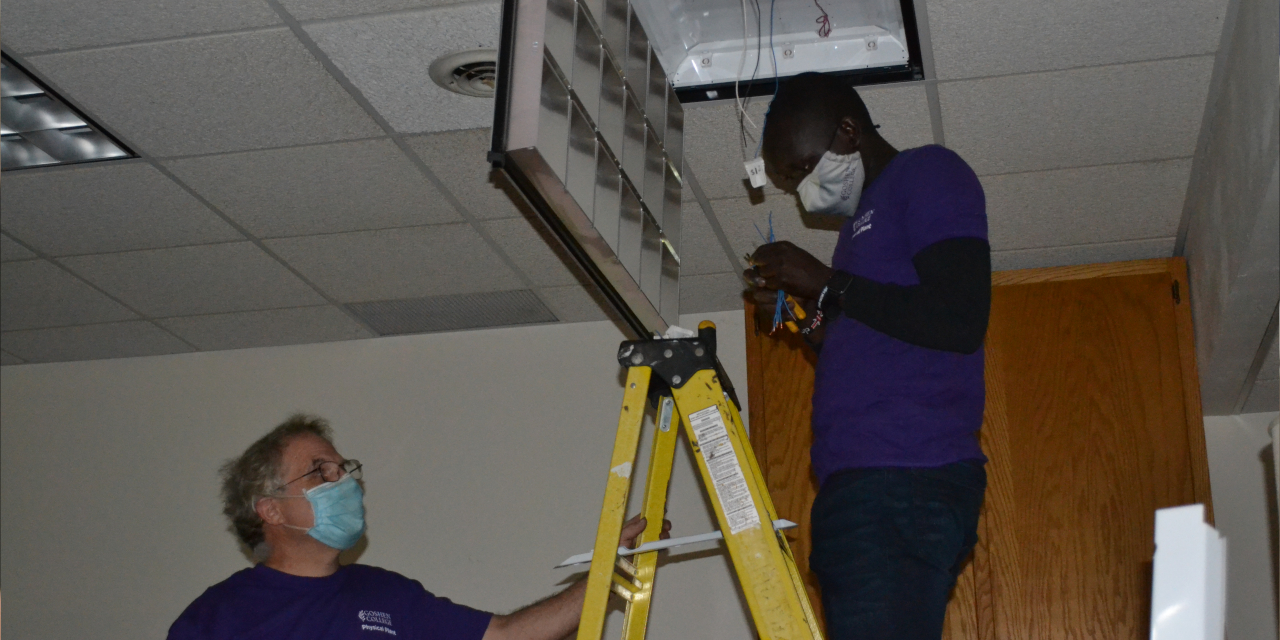Steve Shantz can turn on a lightbulb with his tongue, but that’s only a minor magic trick in comparison to his main stunt with LED lights at Goshen College.
Shantz and his team of student workers are nearing the completion of a multi-year project to switch campus over to LED lighting and drop the college’s energy usage to a new low.Shantz, systems supervisor for the Physical Plant, committed to a college-wide transition to LED lights about two years ago.
The project is now 90% complete, and he plans to keep working until every light on campus has been upgraded, which he foresees happening before the end of the year.
“I want to get away from compact fluorescents as fast as I can,” he said.
Victor Kiprop Kiprotich, a junior nursing major, joined Shantz’s team in January 2020.
He is one of the 10 students who has done most of the work replacing lightbulbs over the last two years, and one of three who worked on the project this spring and summer when campus was shut down due to COVID-19.
The pandemic provided a great chance for Kiprotich, Dan Kipchumba and Zenton Yobera to buckle down on the project. For Kiprotich, he has calculated that he spent a total of 1,000 hours working with Shantz between January and the last day of summer break.
“I had plans for how much I would get done this summer,” Shantz said. “It was the end of July and all of a sudden everything was done that I had planned on.”
Approximately 12,000 LED lights have been installed at this point, which Shantz estimates is about 90% of the lights on campus.
The LED bulbs cost $7 apiece, meaning at least $84,000 has been spent on the upgrade so far. Shantz insists that the cost is worth it because each LED lamp uses 40% less energy than the old fluorescent rods, savings that add up quickly especially with lights that are used frequently.
Shantz has another incentive for wanting to get the new lights installed as soon as possible: They will save custodians and Physical Plant workers a lot of time and energy.
“Once you put LED lights in, you almost never have to change them,” he said.
Like most of Shantz’s student workers, Kiprotich did not know much about working with electrical appliances his first day on the job. Shantz started by teaching him how to change simple light bulbs, but Kiprotich was soon working on more complicated installations.
As they worked, Shantz taught Kiprotich and the other students about the voltage in the wires they were handling.
The job took Kiprotich and others into every building on campus, including his professors’ offices and underground tunnels most students never even know exist.
“I fixed [the lights] where I take my meals at the cafeteria, in the dorm room where I once lived, and in all the classrooms where I will ever be,” he said.
Kiprotich did not want the upgrades to be limited to campus.
He sent some of his paycheck from the job to his family in Kenya to install electric lights in his home.
He gave his family special instructions to get LEDs because, as he learned from Shantz, “they really save the environment and save energy.”
“I didn’t grow up with electricity,” he said.
So when he received photos sent by his family recently, he said, “It was just amazing to see LEDs in my home.”
The new LEDs on campus can be recognized by their neutral white light which contrasts with the cold blue tone of fluorescents. LEDs can produce any temperature of light on the color spectrum, so Shantz had to pick which color to standardize at GC. He settled for a middle-of-the-road light as a compromise between different people’s personal preferences.
The college’s energy consumption has been on a steady downward trend for the last twenty or thirty years, and Shantz expects to see another significant decrease in energy usage this fall.
“We use the same amount of energy now as in 1991,” Shantz said. “Before the Science Building add-on, before the Music Center was built, before the RFC was built, before the Connector was built, before we air conditioned the buildings and before the church addition was done.”
But the LED project is the last project in terms of energy reduction changes, as far as Shantz can tell.
“After this, projects with big energy savings are going to be harder to come up with,” he said.
The way Shantz sees it, that just means he will have to get more creative.
“This is what makes me get up in the morning and get excited about coming to work,” he said.
That and the chance to occasionally wow someone with a mouthful of light.
“It looks really freaky if you don’t know what’s going on,” he said. “You gotta have fun sometimes.”




